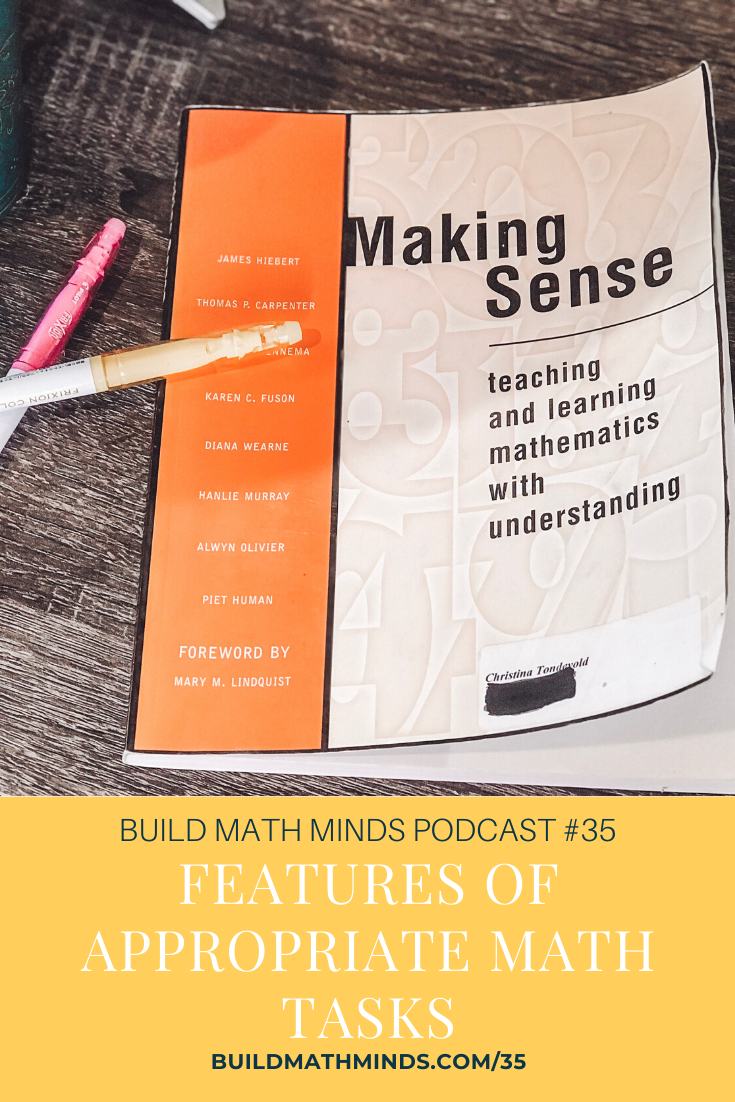Resources mentioned in this episode:
Making Sense: Teaching and Learning Mathematics with Understanding by Hiebert et al
Welcome fellow Recovering Traditionalists to Episode 35. Today we are looking at the Features of Appropriate Math Tasks.
I am 35 episodes in and I cannot believe I haven’t talked about this book yet! Making Sense: Teaching and Learning Mathematics with Understanding by Hiebert et al is one of those books that I have pink highlighter throughout the entire thing.
It was so hard to pick just one passage from this book to share with you today, so I’m sure I’ll share more in future episodes. The whole book gives us a framework for thinking about math classrooms. They highlight 5 dimensions that work together to shape your math classroom, today we are going to look at the first dimension which is The Nature of the Learning Task through this passage from page 8:
“…tasks are viewed as opportunities to explore mathematics and come up with reasonable methods for solution. Appropriate tasks have at least three features (Hiebert et al. 1996). First, the tasks make the subject problematic for students. We do not use this term to mean that students do not understand mathematics or that it is frustrating for them. Rather, problematic means that students see the task as an interesting problem. They see that there is something to find out, something to make sense of. Second, the tasks must connect with where students are. Students must be able to use the knowledge and skills they already have to begin developing a method for completing the task. Third, the tasks must engage students in thinking about important mathematics. That is, they must offer students the opportunity to reflect on important mathematical ideas, and to take something of mathematical value with them from the experience.”
All three of these features are important, but that last line about taking something of mathematical value with them from the experience is a powerful one to think about. Later in the book they talk about this as the Mathematical Residue that is left over after the task. So, I’d like you to contemplate the tasks that you are providing during math time and what is the mathematical residue that is left behind? What big mathematical idea left an imprint?
If you want to learn more about the Nature of the Learning Task and the other 4 dimensions, go get the book Making Sense.
This episode is brought to you by the Build Math Minds Professional Development site. It’s an online site full of PD videos designed specifically for elementary teachers to help you build your math mind so you can build the math minds of your students. If you are interested in getting in depth math PD at your fingertips become a member of Build Math Minds. Just go to buildmathminds.com/bmm. Depending upon when you’re listening to this, enrollment might be open or you can join the wait list and get notified when it opens again.
Subscribe and Review in iTunes
While you’re there, don’t forget to leave a review on iTunes too. I would love to know your thoughts and how we can make sure that we give you content that you will really enjoy.
To leave a review, head over to iTunes and click on “Ratings and Reviews” and “Write a Review.” I can’t wait to hear your thoughts about the podcast.





Thanks for the recommendation. This looks like an extremely useful read.
We had to listen for a ECE class and this was really good information to know as a future educator!